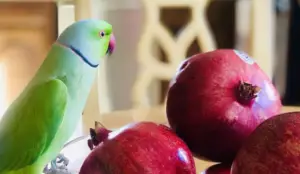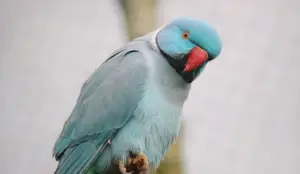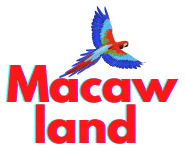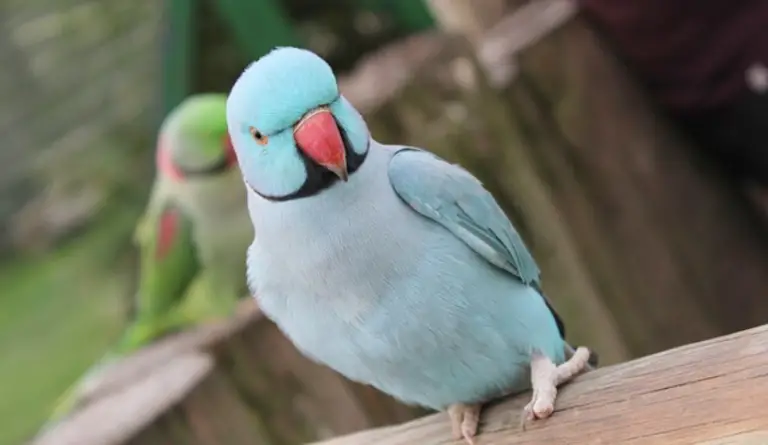Indian Ringneck Parrots are vibrant, intelligent birds known for their distinct coloring and charming personalities. They can be fantastic companions, but potential owners must understand the costs involved in their care. This article will guide you through various expenses, including initial purchase, ongoing care, and hidden costs, ensuring you’re fully informed before welcoming an Indian Ringneck into your home.
What Determines the Price of an Indian Ringneck Parrot?
The price of an Indian Ringneck Parrot varies based on factors like age, color, breeder reputation, and location.
In-depth: The cost of an Indian Ringneck can fluctuate significantly. Younger birds typically cost less than mature ones, and rare colors like blue or yellow may command higher prices. The breeder’s reputation for healthy, well-socialized birds can also affect the cost. Additionally, prices may vary depending on where you live, with urban areas often having higher prices due to increased demand.
Initial Purchase Cost of an Indian Ringneck Parrot
Quick Answer: Expect to pay anywhere from $400 to $1000 for an Indian Ringneck Parrot.
In-depth: The price of these birds depends on several factors, including their age and rarity of their coloration. This cost is generally higher than some other popular pet birds but is justified by their lifespan and the joy they bring. It’s important to purchase from a reputable breeder or pet store to ensure the health and wellbeing of your new pet.
Initial Purchase Cost of an Indian Ringneck Parrot

When buying an Indian Ringneck Parrot, you’re likely to spend between $400 and $1000.
The journey to becoming a proud owner of an Indian Ringneck Parrot begins with understanding the costs involved. These striking birds, known for their beauty and intelligence, come with a price tag that varies based on a few key factors.
Firstly, the age of the parrot plays a significant role in determining its price. Younger birds, often referred to as hatchlings or juveniles, are usually priced lower than fully matured parrots. This is because older birds often have a more developed plumage, are easier to assess in terms of health and personality, and may even have some training already.
Another crucial factor is the coloration of the parrot. Indian Ringnecks come in a variety of stunning colors, ranging from the classic green to more rare and sought-after hues like blue, yellow, or even albino. These rare colors are typically the result of selective breeding and can significantly increase the price of the bird. For instance, a blue Indian Ringneck may cost more than a green one simply due to its rarity and unique appearance.
It’s important to remember that while you might find cheaper options, the initial purchase price of a parrot is often indicative of its quality and the care it has received. A higher price tag can reflect a bird that has been bred and raised in a healthy, nurturing environment, which is crucial for its long-term wellbeing.
Purchasing from a reputable breeder or a well-established pet store is essential. These sources are more likely to provide healthy, well-socialized birds and can offer valuable advice for first-time owners. They should be able to provide detailed information about the bird’s origin, health history, and any care requirements.
Bear in mind that the cost of an Indian Ringneck Parrot is an investment not just in a pet, but in a companion that will be part of your life for many years. These birds are known for their longevity, often living up to 25 years or more with proper care. Therefore, the joy and companionship they bring can far outweigh the initial financial outlay.
Essential Supplies and Their Costs for Your Indian Ringneck
Starting out with an Indian Ringneck Parrot requires an initial investment in a cage, toys, perches, and food, which can total over $200.
The Cage: Your Bird’s New Home
The first and most important item you’ll need for your Indian Ringneck is a suitable cage. Remember, this is not just a cage, but a home for your new feathery friend. A good cage should be spacious enough for your parrot to move around freely, spread its wings, and have space for toys and perches. Depending on the size, quality, and features, a durable and safe cage can cost anywhere from $100 to $300. While it might be tempting to save money on a cheaper cage, investing in a good quality cage ensures your bird’s comfort and safety in the long run.
Toys and Perches: Keeping Your Bird Entertained and Comfortable
Just like us, birds get bored too! Toys are essential to keep your Indian Ringneck entertained and mentally stimulated. These intelligent birds love puzzles, chewable toys, and mirrors. Rotating the toys regularly is also a good idea to keep things interesting. Perches of varying diameters are vital for foot health and comfort. When setting a budget for toys and perches, expect to spend between $50 and $100. This range allows you to provide a variety of toys and perches, catering to your parrot’s natural behaviors and needs.
Food: Nutrition is Key
Your Indian Ringneck’s health is closely tied to its diet. A balanced diet for these birds includes high-quality pellets, fresh fruits, vegetables, and occasional seeds or nuts as treats. The cost of food can vary, but on average, you’ll spend around $20 to $30 per month on a nutritious and varied diet. While it might be tempting to opt for cheaper food options, remember that a healthy diet is a cornerstone of your parrot’s overall health and well-being.
Ongoing Care Costs for Indian Ringneck Parrots
Monthly expenses like food, veterinary care, and grooming can average $50 to $100.
In-depth: Regular costs include nutritious food and occasional treats. Routine vet check-ups are essential, and while they vary in cost, setting aside $200 to $300 annually for veterinary care is a wise decision. Though these costs are relatively minor, grooming supplies or professional grooming services are also a factor.
The Hidden Costs of Indian Ringneck Parrot Ownership
Time and potential property damage are hidden costs of owning an Indian Ringneck.
In-depth: Indian Ringnecks require significant time for social interaction and training. Neglecting their social needs can lead to behavioral issues. Also, their chewing habit might damage property, so be prepared to replace or repair items like curtains or furniture.
How to Budget for an Indian Ringneck Parrot

When budgeting for an Indian Ringneck Parrot, it’s important to account for both the initial costs (like purchasing the bird and essential supplies) and the ongoing expenses (such as food and veterinary care). Additionally, setting aside money for an emergency fund is crucial for any unexpected costs.
Budgeting for an Indian Ringneck Parrot isn’t just about the initial cost of the bird; it involves a comprehensive plan covering both start-up and ongoing expenses. Here’s how to do it effectively:
- Understand Initial Costs: The first step is to know what you’re getting into. The purchase price of an Indian Ringneck can vary, but that’s just the beginning. You’ll need a sturdy cage, quality food, toys for mental stimulation, and other supplies like perches and grooming tools. Research these prices in your area or online to get a realistic idea of the total initial investment.
- Plan for Regular Expenses: Like any pet, Indian Ringnecks have recurring costs. This includes food, which needs to be high-quality and varied, regular health check-ups, and replacing toys and accessories. Monthly, these can add up, so it’s wise to draft a monthly budget. Keep in mind that while some costs like food are predictable, others, such as vet visits, can vary.
- Set Aside an Emergency Fund: Unexpected situations, like illness or accidents, can lead to significant veterinary bills. Having an emergency fund specifically for your parrot can be a lifesaver in these situations. It’s recommended to start this fund as soon as you decide to get a parrot and continue adding to it regularly.
- Consider Long-Term Costs: Owning a parrot is a long-term commitment, as Indian Ringnecks can live for over 20 years. Think about the future costs, including potential increases in veterinary care as they age.
- Look for Ways to Save: There are ways to reduce costs without compromising on care. For instance, buying food and supplies in bulk, making DIY toys, or learning some grooming techniques can save money in the long run.
- Stay Informed and Flexible: Prices can change, and your parrot’s needs might evolve. Regularly review and adjust your budget as needed. Staying informed about parrot care can also help you anticipate and manage costs more effectively.
By following these steps, you can ensure that you are financially prepared for the joys and responsibilities of owning an Indian Ringneck Parrot. Remember, responsible pet ownership isn’t just about providing love and attention; it’s also about ensuring that you can meet their physical needs throughout their life.
Alternatives to Buying: Adoption and Rescue
Adopting a rescue Indian Ringneck can be a cost-effective and rewarding option.
In-depth: Adoption is often cheaper than buying a new bird, with costs usually covering health checks and vaccinations. Rescuing a bird can be incredibly rewarding, though it’s important to be aware of potential behavioral issues stemming from their past experiences.
FAQs about Indian ring neck parrot cost
What is the lifespan of an Indian Ringneck Parrot, and how does it impact cost?
Indian Ringnecks can live for 20-30 years, making them emotionally and financially a long-term commitment.
Can I reduce costs by training and grooming my Indian Ringneck Parrot at home?
Yes, home grooming and training can reduce costs, but it’s important to learn the proper techniques to ensure the safety and well-being of your bird.
Are there any subsidies or support programs for exotic pet owners?
Subsidies are rare, but some regions have support programs or clubs for exotic pet owners that offer resources and shared costs.
How does the cost of owning an Indian Ringneck compare to other parrot species?
Indian Ringnecks are moderately priced compared to other parrots, with costs influenced by their lifespan, care needs, and the joy they bring to their owners.
Conclusion
Understanding the full cost of owning an Indian Ringneck Parrot is essential. These birds are not just a purchase but a commitment to a living creature that requires time, money, and love. Consider all aspects before making your decision to ensure a happy and healthy life for your new companion.

Hi, I’m Regina Rios. Just another bird lover who loves to share knowledge from personal experience. I’ve grown up with pet birds since childhood as my mommy also loves birds. As I can’t pet many birds in open air in my house as my mom does; I created my first bird cage on my rooftop using wood, copper wire, and a metal shed in 2018 and start collecting pet birds. Now, I have so many pet birds such as Macaws, Parrot, Cockatiel, Parakeet, and others. Not only that, if I see natural birds are injured I keep them in my house until they get well. Now, my hobby becomes my income source as my home birds have babies and I sell them to birds lover like mine. I’ve created this blog to inspire others bird owners by sharing my personal knowledge. Good Luck!

